Sunday Spotlight: The rise of the Esplanade
SINGAPORE — Set for an expansion as it marks its 15th anniversary this year, it is easy to forget that the multi-million dollar Esplanade was opened in October 2002 to huge scepticism.
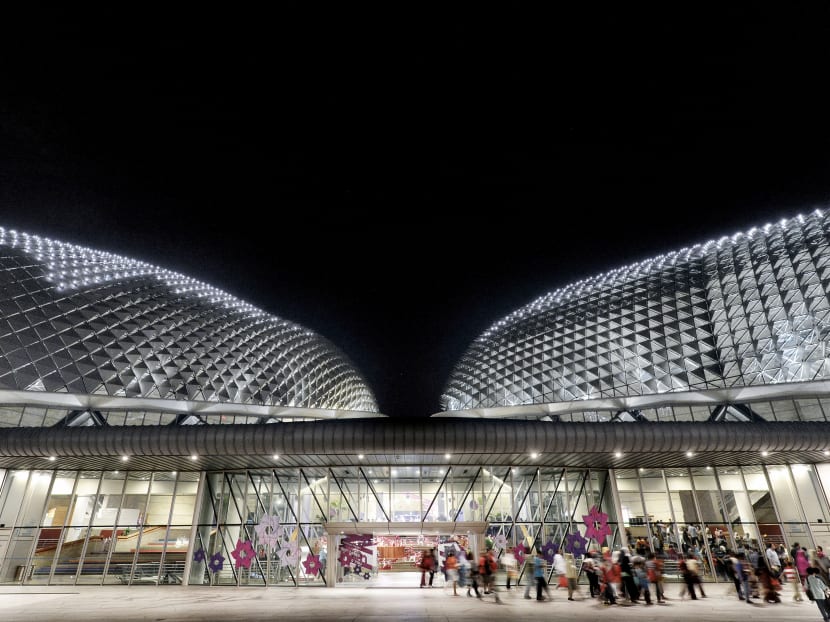
A view of the exterior of Esplanade during the centre's 10th anniversary weekend in October 2012. Photo: Esplanade - Theatres on the Bay
SINGAPORE — Set for an expansion as it marks its 15th anniversary this year, it is easy to forget that the multi-million dollar Esplanade was opened in October 2002 to huge scepticism.
Would it work as an arts venue? Was the “durian” design too avant-garde and lacking in appeal to the man-in-the-street? Would Singaporeans and arts and music practitioners alike embrace it and make it their own?
Today, the Esplanade — shimmering silver spikes and all — has become an icon in the Marina Bay area, drawing huge international names in the music, dance and theatre scenes.
The journey for the Esplanade began in 1979, when the late President and then-Minister for Culture Ong Teng Cheong brought to Parliament his intention to create an arts centre “to provide more facilities for the mushrooming of local cultural activities”.
The official announcement for the venue was issued in 1990, in a climate of economic uncertainty when Singapore was just coming out of its first post-independence recession. Murmurs of discontent started then. And when construction began in 1996, the murmurs grew into a clamour.
The Esplanade’s chief executive, Mr Benson Puah, said: “The public questioned why we were doing this, and who (the complex) was for.”
The presumption by many was that “it’s obviously not for me”, he added. People assumed it was for “the cultural elite”.
Arts practitioners were initially excited by the idea of a huge arts complex — one venue with a big theatre, as well as potential mid-sized and small spaces for various productions.
But in 1994, it was announced that the Esplanade would have to be built in two phases because of the scale and cost of the project. The largest spaces — the Concert Hall and the Theatre, with a capacity of 1,600 and 1,950 respectively — as well as the smaller Recital and Theatre Studios were to be built first. It fell to Singapore’s Ambassador-at-Large Professor Tommy Koh, who was then chairman of National Arts Committee and a member of the steering committee, to announce that the development of the medium-sized space was to be put on hold, with no definite date set.
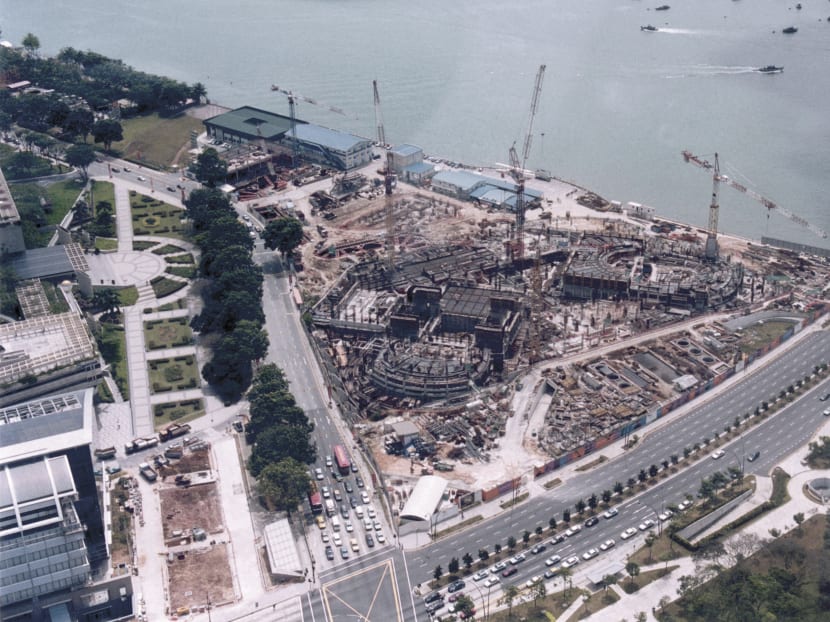
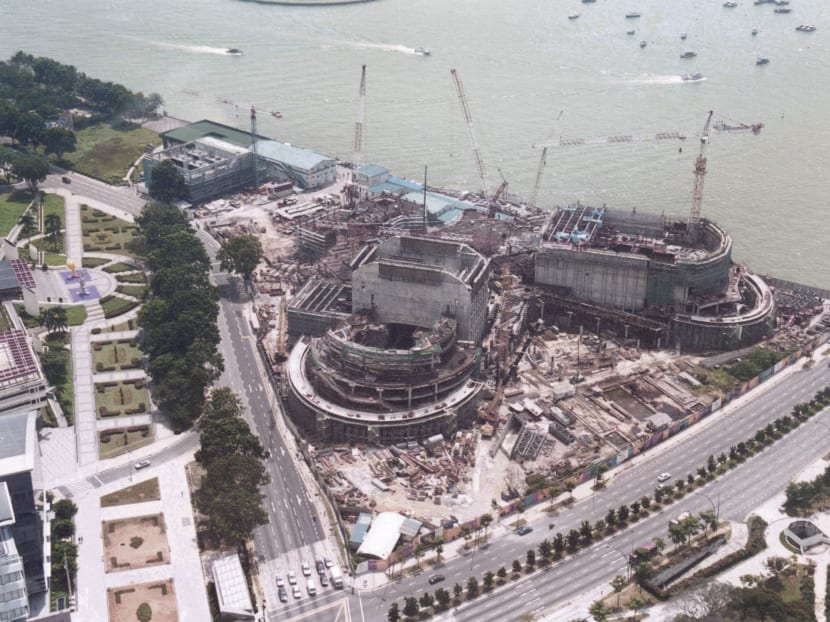
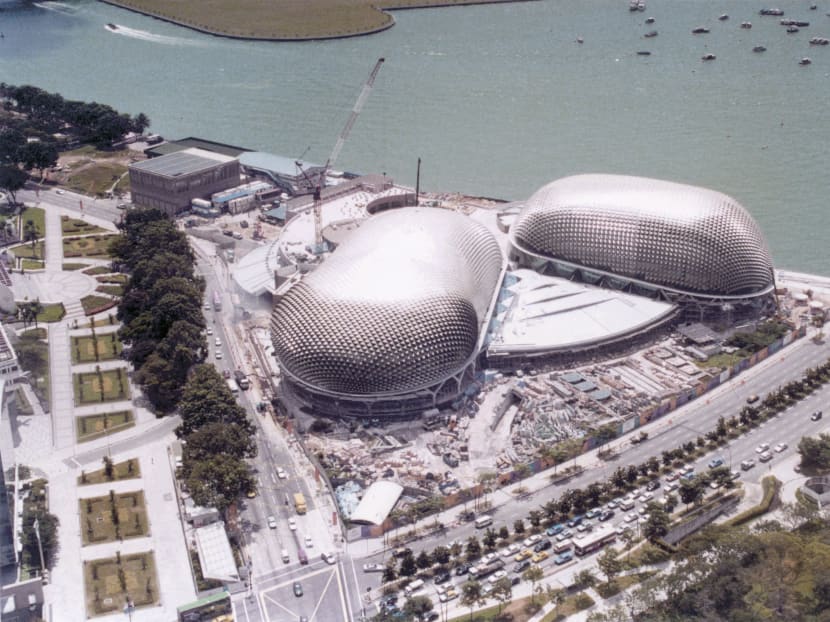
The Esplanade’s “durian” design taking shape. Following the groundbreaking ceremony on 11 August 1996, construction of the arts venue began, and took about six years to complete. It was officially opened by then President S R Nathan on 12 October 2002. Photos: Esplanade - Theatres on the Bay
According to Prof Koh, he was the “bad guy” who had to break this news to the local arts groups, for whom a mid-sized space was important for them to upscale their works.
“Many of my artist friends were very disappointed. Some felt that I had betrayed them. Others wondered whether there would ever be a phase two,” he said.
Add to that the fact that the final figure for the complex was to be just over S$600 million, and there was a public storm.
Even its architecture was a question mark, with many saying it was an “ugly concrete blob”. Those such as Mr Vikas M Gore from DP Architects, the company behind the Esplanade’s design, remember how the building was first called “the Durian” as “a joke and a criticism”.
Mr Gore, who was the project director in charge of the Esplanade project, added: “I have a collection of other names it was called, not all of them printable.”
Mr Puah felt all this keenly.
“During the period before we opened, we knew that there was much we needed to do to win back our people,” said Mr Puah. “The first thing we asked ourselves was: Why are we really here?
“The answer was clear for all of us. We are here to serve our people through the arts ... We know no amount of talking could change anybody’s mind until we opened, and demonstrated where our hearts were,” he said.
THE LOW POINTS
Today the Esplanade is an iconic structure known for a diverse programme that encompasses contemporary as well as traditional forms of music, dance and theatre. Say “Mosaic Music Festival”, and one immediately thinks of the year the Esplanade brought in American hip-hop trio N.E.R.D. The Huayi — Chinese Festival of the Arts has seen heavyweight names such as thespian Anthony Wong taking to the stage not once, but twice, at the building. Its da:ns series has seen major international productions such as Giselle and Don Quixote while most recently, The Third Space showcased works by Cultural Medallion recipient Lim Fei Shen.
On the local front, the Esplanade is known for pushing boundaries. The centre commissioned two Singapore arts groups — Singapore Dance Theatre and Singapore Repertory Theatre — to produce Reminiscing the Moon and Forbidden City respectively, two large-scale works which were part of the centre’s opening festival line-up.
In the early years, however, some remember that the Esplanade’s halls were empty. Ms Nathalie Ribette, artistic and executive director and founder of Sing’theatre said: “In the beginning, I had doubts on whether the public would visit the Esplanade unless they have had paid for a ticket to a show. In the initial years, the corridors were often empty.”
The Esplanade was also hosting international shows such as Singin’ In The Rain (2002), Oliver! (2003) and Mamma Mia! (2004).
This led to worry that the Esplanade’s programmers had “high performing standards”, and that local productions would not stand a chance, according to Mr Chin Choy Liew, company manager of dance company Frontier Danceland and the general manager of Singapore Symphony Orchestra from 1999 to 2004.
“The Esplanade was quite selective (then) about groups going into the facilities to stage performances. Amateur groups, school groups had difficulty getting into the complex,” he said.
However, according to Mr Puah, there was always a focus on smaller and local arts groups.
“This may not have been apparent, especially in the early years, as the programmes which took place in our big venues then were often international presentations, such as popular musicals. These tended to be given more prominence by the media and thus, may have given our artists and the public the impression that only international artists performed at the centre,” he said.
The Esplanade, however, found a turning point in public perception through an unexpected avenue: Concerts.
A MUSICAL FORCE, CHANGING PERCEPTIONS
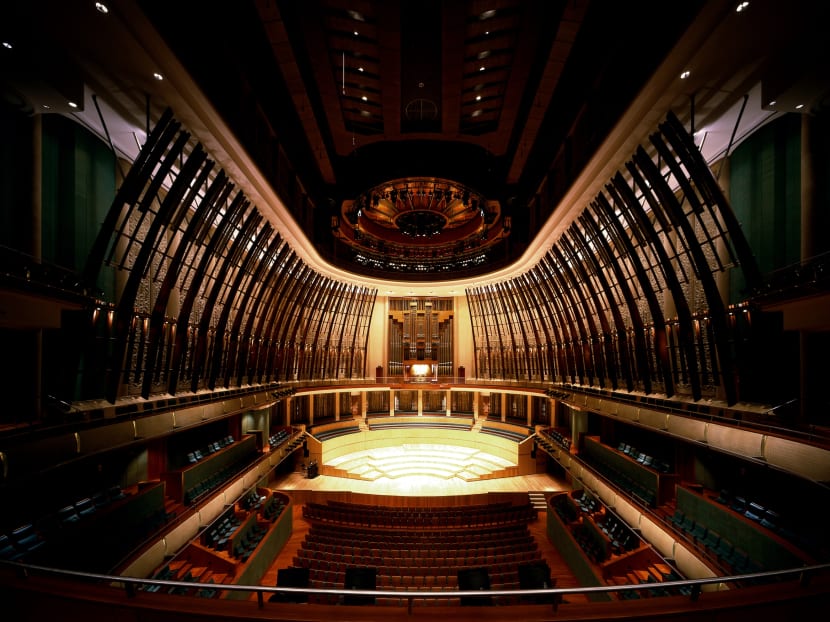
The Concert Hall is Esplanade's crown jewel, which seats 1,630 and another 197 in the gallery. It was chosen by Hamburg-based building data company Emporis in 2014 as one of the 15 most beautiful concert halls in the world. Photo: Esplanade - Theatres on the Bay
The arts venue quickly became a ground-breaking force in music. In the 1990s, the Indoor and National Stadiums were where big acts would play shows.
But with a state-of-the-art sound system and acoustics, the Esplanade became a welcome alternative. It brought in the great American jazz chanteuse Shirley Horn in 2005, American singer-songwriter Jason Mraz in his Singapore debut in 2006, popular American trumpeter Chris Botti in 2008, and celebrated Canadian singer k.d. lang in 2011.
But The Esplanade in 2002 also decided to champion Singapore music, hosting its first Baybeats festival then. The free, three-day annual festival is dedicated to alternative rock and local bands.
Mr Mohamed Hanis Isahak, bass player of experimental music group Sub:Shaman, said he initially thought that the Esplanade was an “atas” place just for cultural shows. That is, until he went to the first Baybeats.
“I experienced Force Vomit, My Squared Circle, Fishtank, Moods, and so many more bands that weekend,” he said. “It had a profound impact on me.”
Mr Hanis, 29, a project manager, added: “I still check out the Esplanade programmes and discover many cool bands from Singapore and the region. The programming has continued to stay on the pulse of our independent music scene.”
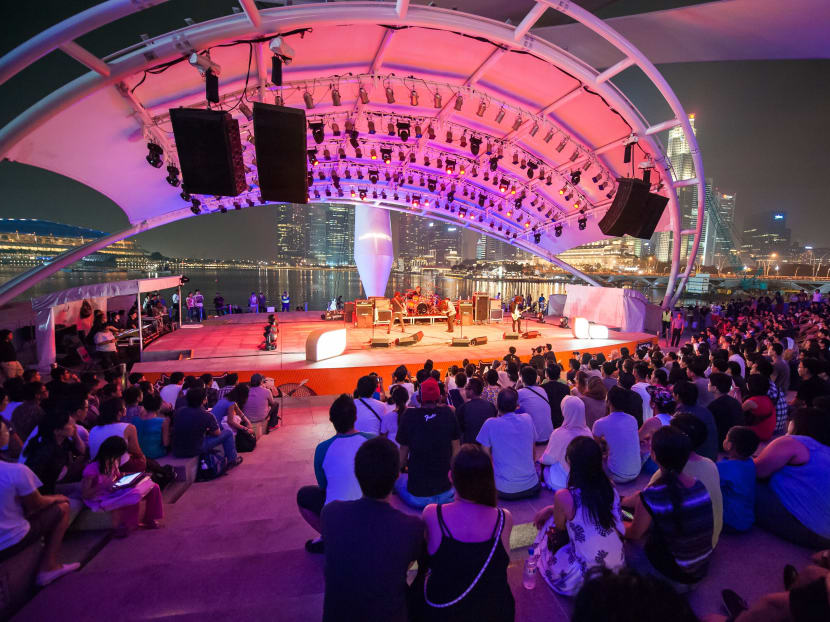
Fronting the 300m long waterfront along Marina Bay, the Esplanade outdoor theatre can seat 450 people and accommodate up to 600 standing. The space hosts a diverse range of performances from music to dance and theatre, which can be enjoyed under the night sky. Photo: Esplanade - Theatres on the Bay
And then came the Mosaic Music Festival in 2005.
“From the first half of 2000s ... it was clear that Esplanade was willing to go out on a limb and invite artists from different genres, known as well as emerging,” said Mr Yeow Kai Chai, former music reviewer for The Straits Times Life!. “The main vehicle was the Mosaic Music Festival, which was responsible for cultivating the contemporary music fan’s taste, and introducing acclaimed foreign acts such as Joanna Newsom and Rickie Lee Jones”
The Mosaic Music Festival debuted in 2005 but saw its last installment in 2014, despite tremendous success. Mr Puah said the festival ended because it had “served its purpose”. Newer festivals such as the St Jeromes Laneway Festival, which first came to Singapore in 2012, were springing up.
“Its success was building audiences for many different genres and forms of music, to the extent that commercial promoters could actually take it on,” Mr Puah said, adding that passing the torch to others has always been his intent for Mosaic.
The brand, however, lives on. Last year, the Mosaic Associate Artist programme was launched along with the venue’s new Annexe Studio. The aim: To offer artists here more dedicated support by giving them opportunities for residencies and production support. The programme is tied to the Esplanade’s new Annexe Studio, a space for rehearsals, performances and the like.
Singapore jazz musician Chok Kerong and instrumental metal band In Each Hand A Cutlass are part of the programme.
The Esplanade had also debuted one of Singapore’s largest local music festivals, Baybeats, in 2002. The free, three-day annual festival is dedicated to alternative rock and local bands.
IN THEATRE
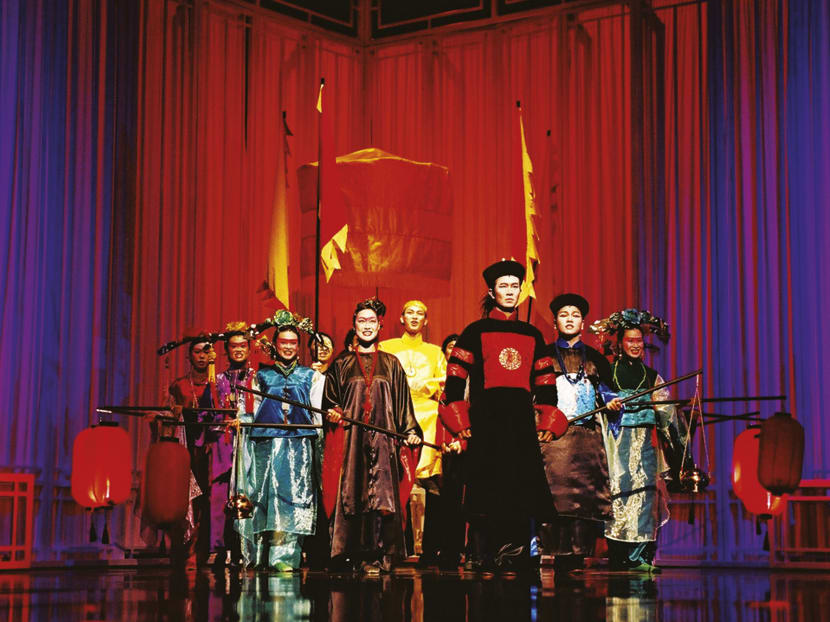
"Forbidden City: Portrait of an Empress" was first staged by Singapore Repertory Theatre at the opening festival of Esplanade in 2002 and then later restaged twice in 2003 and 2006, due to popular demand. The musical will return to the Esplanade again in August 2017. Photo: Esplanade - Theatres on the Bay
Since its opening, the Esplanade managed to gain traction with local theatre groups.
Those like Apsaras Arts, the Indian classical dance theatre company, have received a huge boost thanks to support from the arts venue.
Creative and managing director Aravinth Kumarasamy, 51, said that around 2002 — when the Esplanade opened — was when the dance company set its sights on transforming itself into a more professional body.
It got its start primarily as a dance school in 1977, but was focused on small, ad-hoc productions up to the early 2000s.
The Esplanade allowed the company to work with them, “co-producing ... productions, and programming the Company in its annual festivals”, said Mr Kumarasamy, who has been with Apsaras Arts since 1990.
“Over the years, the company has gained experience in creating and presenting works in its world-class venue, working with professional technical resources,” he added. All that experience led them to understand what it took to be on a world stage. Working with the Esplanade “enabled the company to build its brand as an international Indian dance company”, he added.
A number of Apsaras Arts’ projects have gone on international tours after premiering at the Esplanade, he noted. Among them is Angkor, co-produced by the Esplanade. The curtain-raiser performance for Esplanade’s annual Indian arts festival – Kalaa Utsvam 2013, it brought together artists from five different countries. Mr Kumarasamy describes it as “one mega production” that went on to show around the region. Other works from Apsaras Arts have also gone on to show in London and India.
“Partnering with Esplanade brought us new audiences,” said Mr Kumarasamy. “The initial perception was that the Esplanade would only focus in presenting top international works. But it has been true to its vision of being there for all.”
Likewise, the partnership with Esplanade has led to international collaborations for SRT, said Ms Charlotte Nors, executive director at the company. Such collaborations saw them working with the Royal Shakespeare Company on King Lear (2007), and Sam Mendes’ trans-atlantic The Bridge Project, which famously brought in Richard III, starring Academy Award-winner Kevin Spacey, 2011.
Today, the Esplanade continues to champion small groups. The Teng Company, a small arts company focusing on Singaporean Chinese music, credits the Esplanade for pushing them forward. In 2013, the Esplanade commissioned an ensemble show for its smaller Recital Studio space. Last year, programmers practically arm-twisted the company into holding its first Concert Hall show.
Dr Samuel Wong, pipa player and board member of the company, recalls how the ensemble was worried that tickets would not sell — but they did. The one-night-only show last year (2016), directed by Singapore theatre icon Glen Goei, “sold like hotcakes”, said Dr Wong.
COMPETITION RULES
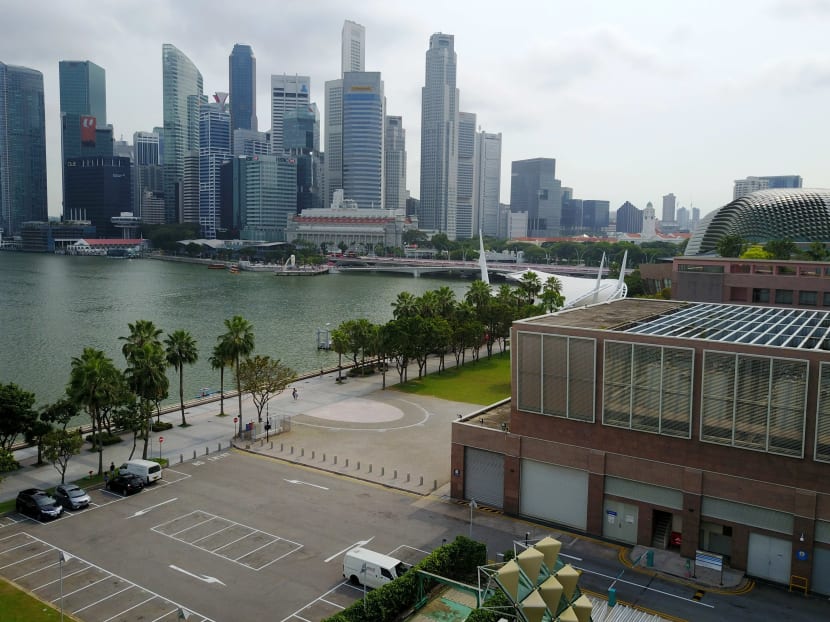
The proposed site of the new mid-sized theatre at the Esplanade. Budgeted at S$30 million, it will be able to seat up to 550 people, and offer the arts venue more flexibility in terms of programming. Photo: Mugilan Rajasegeran/TODAY
Despite its roaring success, the Esplanade is no longer the only premiere theatre in town. The opening of the Marina Bay Sands (MBS) theatres in 2010 has meant that top international acts and productions also flock to that venue, just across the river.
Frontier Danceland’s artistic director Low Mei Yoke said that since then, she has noticed that large-scale musicals are held there, rather than at the Esplanade.
Long-running and popular block-buster commercial productions at MasterCard Theatres at MBS include Disney’s The Lion King, which made its South-east Asia debut in March 2011, and award-winning West End musical Wicked (2016).
Mr Puah is “mindful” of competition, noting that “MBS makes enough net profit to make Esplanade all over again”.
But he added that “I see every venue as adding onto the ecosystem. In business, one tends to destroy the competition”. The Esplanade has taken the view “that we would support different venues, because they would attract different audiences”, he said.
There are those such as Ong Keng Sen, director of the Singapore International Festival of Arts, who feel that the Esplande has “hit a glass ceiling”. His worry: Over-centralisation.
“I have heard audiences say that they are tired of going to the Esplanade again, even if they are seeing different things,” he said.
He encourages arts groups to look beyond the Esplanade and experiment with different spaces.
“There have been very experimental projects in Europe for example, where people ‘trade’ buildings,” he said. “So, I work in your building and you work in my building.”
He suggested that the Esplanade ought to be radical, and “change identities for a season” with, say, the National Gallery Singapore. This would shake things up and give it a chance to reshape itself.
Acclaimed local playwright Alfian bin Sa’at said: “Even as the Esplanade makes resources available for local theatre makers, it should not be seen as the only entity in town with the capability to mount festivals and public programmes.”
Although Mr Puah recognises that tastes have changed, and that the Esplanade is entering into a new season of life, he said that the content and programmes Esplanade is able to present is still at “the tip of a very large iceberg”.
He said: “The next 15 years (should not be) a straight line growth for us, it has to be a rejuvenation. Do not expect things to stay the same. The new generation has totally different expectations ... from what we do now ... I think that’s hugely exciting because culture doesn’t stand still, does it? And we are not.”
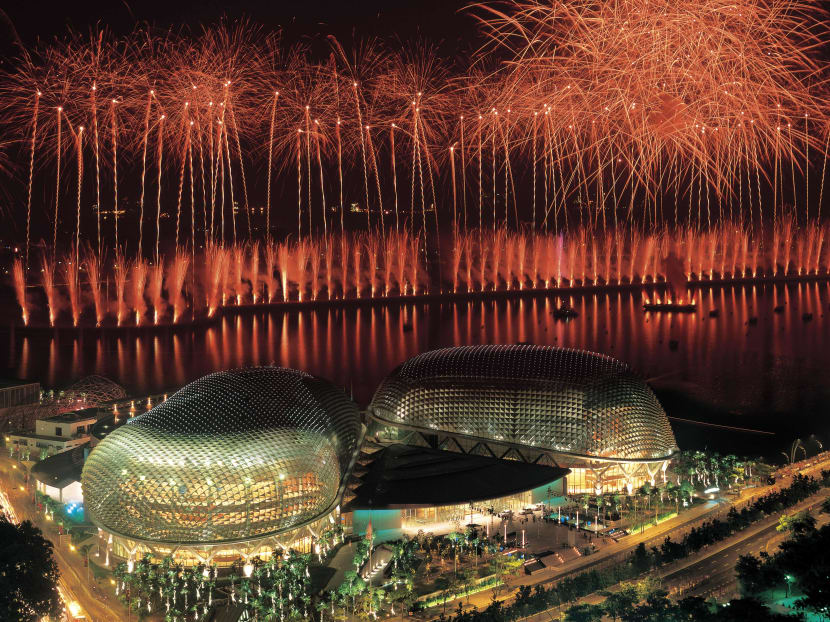
A pyrotechnics spectacular lights up Marina Bay to celebrate the opening of Singapore's first purpose-built performing arts centre. The highlight of the opening celebrations was a 23-day festival that featured 1,300 artists from 22 countries and attracted more than one million visitors to its over 600 performances. Photo: Esplanade - Theatres on the Bay
To start with, that mid-sized theatre that caused so much consternation in the beginning has finally been announced. The news came last month that it is set to be a 550-seater on the waterfront, costing S$30 million and to be completed in 2021.
“With a waterfront theatre, there is so much more we can explore. We have served people as best as we could with large and small venues,” said Mr Puah. “Many works we have (put on) are (actually) for a mid-size theatre. So, the possibilities (for the future) are mind-boggling. I firmly believe it will be a game-changer for the scene. It is actually going to be the engine for growth for us.”






